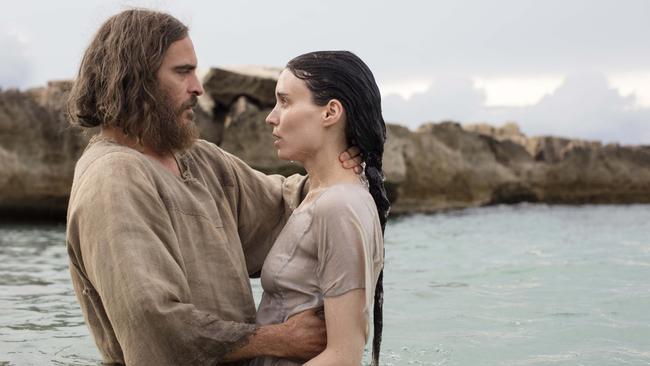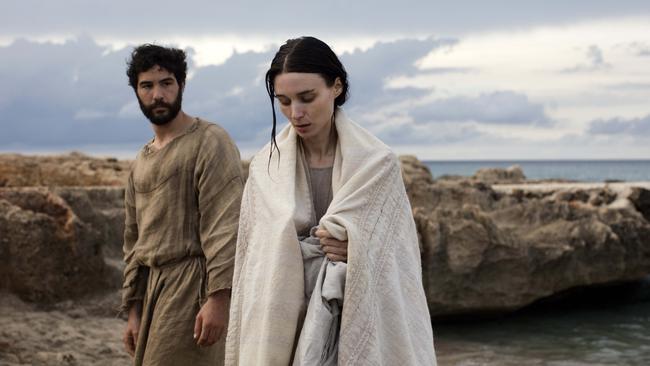Mary Magdalene: Garth Davis film shows spiritual woman in man’s world
One of the Bible’s most contentious characters is given new life in Mary Magdalene, Aussie director Garth Davis’s new film.

Mary Magdalene, the fallen woman. The outsider, the outcast, often depicted as a prostitute, a figure shunned by society. Penitent, redeemed by religion — rarely, in these accounts, a spiritual figure in her own right.
In Garth Davis’s Mary Magdalene, the image of falling takes a very different form. His movie is framed by the figure of a woman underwater, fully clothed, falling backwards, arms outstretched, slipping further and further into the depths. Not drowning but letting go.
For Davis — the Australian director who made his feature debut with Lion — this is the essence of Mary Magdalene. “The underwater imagery is basically a metaphor for her spiritual calling,” he says. “It’s a visualisation of that place we go to when we question who we are and what we’re connected to. So at times it can be scary and at times it can be joyous. It’s a tumultuous emotional metaphor. It’s having the courage to surrender.”
Mary Magdalene stars Rooney Mara as the title character and Joaquin Phoenix as Jesus. Tahar Rahim (A Prophet, The Past) plays Judas and Chiwetel Ejiofor (Dirty Pretty Things, 12 Years a Slave) is Peter. It’s a quiet, almost intimate depiction of a narrative that cinema has often treated in a more histrionic, epic fashion.
Mara — whose movie roles include The Girl with the Dragon Tattoo, Una and Carol, and who made Lion with Davis — was taken aback when she read the screenplay by Helen Edmundson and Philippa Goslett. “I was kind of shocked that her story had never been told, it had been so grossly miscast,” she says. “You know, I was surprised that she was a such a profound feminist figure and I didn’t know that, I didn’t know anything about her.”

Mara went to a Catholic school, and had a passing awareness of Mary Magdalene: “I had known her to be a prostitute who Jesus sort of saved and she became one of his followers, but I obviously didn’t know anything about her. I don’t think I ever thought about her that much.”
Intrigued as she was by this new perspective, she still had reservations about taking the role. “I was so hesitant to become involved, to be honest, even after reading it and finding all that out, because of the religious content of the film. It was really Garth. I had just worked with him on Lion, and I wanted to work with him again, and the way he spoke about the film he wanted to make really resonated with me, that was what pushed me into it.”
Her reservations, she says, had to be put aside. “Coming from a religious background myself, I didn’t feel like revisiting all that baggage. But it was great to put all my own baggage aside and get to relearn all of this stuff as an adult, that was really interesting.”
The figure Mara plays in the film is an outsider, but for very specific reasons, she says. “She’s a very tactile person, tapped into other people and the way that they’re feeling. I definitely think she’s an empath and that gives her this ability to connect with people in a way that might be different from a lot of other people during that time.”
It is Mary talking to Judas, for example, who reveals his misconceptions and weak points, the reasons why he might see the betrayal of Jesus as a necessary act. Judas, played with warmth and exuberance by Rahim, tells her what he expects from the figure for whom he has given up everything. Mary’s insights allow her to understand and forgive. For Davis, “her relationship with Judas is a great way for the audience to fully realise unconditional love”.
Mara says it makes sense to her that Mary would elicit things from Judas that the other followers could not. “I think women have — and probably especially so during that time, because they were so marginalised — a stronger sense of empathy and compassion and understanding.”

When Davis first read the screenplay, he had certain preconceptions, chiefly cinematic, about the figure of Mary Magdalene. “In movies I’d seen her portrayed as the prostitute, the fallen woman. So when I read it, this was a completely different conversation and I couldn’t believe her story hadn’t been told.”
Mary Magdalene (Mary from Magdala) appears in the gospels of the New Testament a dozen times. She followed Jesus from Galilee; she is present at the crucifixion; and she is the first to witness the resurrection. There are other apocryphal gospels — including a Gospel of Mary, written in the early second century — that develop her story. She was considered an apostle, and is a saint. Yet in a homily by Pope Gregory in 591 she is spoken of as a prostitute: this, it is believed, is an important source for Mary Magdalene as an emblem of repentance.
The screenplay, Davis says, “made sense to me. These people were relatable, there was a spirituality in them, it was inclusive, it was human ... I really felt for Mary and her struggle to follow her calling.”
His favourite film, he says, is John Cassavetes’s A Woman Under the Influence, starring Gena Rowlands as a wife and mother defined by complexity and vulnerability. He also mentions Lars von Trier’s Breaking the Waves, with Emily Watson at the centre of a tormented and tormenting story of faith, abuse and sacrifice. “I gravitate towards stories of women who have these beautiful spirits but are unable to fully realise them because of society, and because of men. I’ve always had a fascination with that.”
The Mary Magdalene of Davis’s film is considered by those close to her to be dangerous, even possessed. Her family members are alarmed by the way she expresses spiritual longings and by her unwillingness to embrace a traditional female role.
We also see her, early in the film, as a midwife and a healer. Mary knows her capacities but the people around her do not, Davis says. “Mary is already in contact with her spirituality, she already is a child of light, as Jesus would say. But this is not allowed to be expressed and fully realised. When she meets Jesus, it’s the first time someone acknowledges who she is and acknowledges that what she has is divine and right and she’s not demonic, she’s not possessed.”

The film’s restraint, Davis says, is essential to its vision. “The message of the movie really is that God is within us, and that we have to embrace our own unconditional love and the spirituality that is in us, so in some ways I had to create that feeling in the making of the movie. And in the silences.
“Jesus talks about the silences. That’s where truth is, being in the moment. In some ways, I had to go against traditional drama and bring people into those silences.”
It was an approach, Davis says, that was congenial to Phoenix, who threw himself into research and exploration. “He did a lot of reading, he has a strong spirituality himself and he’s actually incredibly connected to this concept of unconditional love.”
They found influences in common, he says. “One of the inspirations I had, which Joaquin also serendipitously had, was Martin Luther King’s final speech.” King’s words, Davis says, suggest an awareness of impending death. “There’s a moment in that speech where you can see that he has to leave this earth, and he’s telling everybody that they need to continue the fight, and there was something so beautifully real about that.
At the same time, Davis says, Phoenix was also committed to a natural way of speaking, to creating a figure who was responsive to those around him. “One of the things he was keen on was to not make it seem like Jesus was reading parables but to try to find a way he would have spoken to people, to try to find that energy and language and how that conversation would be inspired by the people around him, how he’d build on something.”
“But the thing that probably moved me the most was the healing sequences. You can’t ‘act’ that stuff, it just doesn’t work.”

For these scenes, Davis says, he didn’t bring in actors to play the roles of the sick and the dying — what he looked for was “people who are self-contained”.
“I would literally bring in people, he wouldn’t know who was coming, and he’d just be in character. Joaquin has a magical ability to empathise with people, he almost sees into your soul and I think people are really drawn in and open up. There were incredible scenes where he would discover the people in front of him, there was a tactility and love that was just quite extraordinary.”
Preparing to make the film, Davis says, he had to do a good deal of research. “I wanted to make sure I’m not offending anyone. I’m not a religious person and I had to do a lot of catch-up.” He trusted the script, he says. “The writers had spent four years invested in the process, already a strong dialogue with experts in the field. It was written from a really respectful place. But I had to go through that myself too.
“We had to have lots of research and people from different religious backgrounds supporting us: experts on first-century history, theologians. We needed great advice.”
His cast members were also encouraged to make use of this: “Actors have a lot of questions, we give them access to these people too.”
There was a need, he says, to try to create a plausible, authentic world of the everyday. “That’s what I have to bring to life. How do they eat? How do they live? How do they sleep?” He wanted the cast to be aware of this. “We had a huge amount of visual material as well, especially in the art department, and I always encouraged actors to go to the art department and walk through the rooms and interact with props. We did rehearsal with props too. It’s all about getting out of a modern headspace.”
Mary Magdalene was filmed in southern Italy and Sicily. Davis, Mara and Phoenix went to Israel shortly before shooting began, to see the biblical locations for themselves. “Garth thought, and I thought, it was important to visit some of those places in the flesh and get a feeling for them,” Mara says. “And it was great, it was amazing to go there” — particularly, she says, to Magdala, where Mary came from.
Yet filming in Italy, she says, had a feeling of authenticity: “That makes such a difference, you can feel how ancient it is.”
For Davis, “It was amazing when we came to Italy how similar it was to images and references I had. I’m not a fan of big CGI worlds, and even sets I struggle with. So I tried to find existing architecture that we could either augment simply or have the actors around — because I really believe in getting the actors into a real world and connect to their characters.”
The landscape is an important part of the film’s identity, he says. “I just think that in a lot of religious dialogues we forget nature, we forget our connection to nature. Nature would have been a very big part of their lives back then. And I think that when you’re in nature, you question who you are and what you belong to, so for me it was a very important element in creating that emotional experience and that spiritual questioning.”
Mary Magdalene opens nationally on Thursday.
